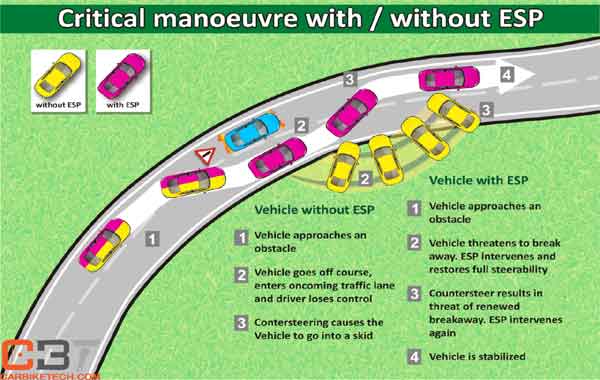ESP/ESC in cars explained?
Imagine you are driving a high-speed car and suddenly coming across an obstacle. Such a scenario will force you to take a sharp turn or apply brakes to avoid a possible collision. However, while doing so, you might lose control and skid off the road. Thus, it may lead to an untoward incident such as an accident. Also, the car you are driving may tip over. So, to avoid this situation, the manufacturers employ the Electronic Stability Program or Electronic Stability Control system. It is one of the active safety systems in a modern car.
Furthermore, ESP stands for Electronic Stability Program, while the ESC for Electronic Stability Control. It is an intelligent safety system that can predict driving intentions. Firstly, the ESP helps the driver to maintain the wheel trajectory. However, it does so by applying brakes to the individual wheels. Secondly, it can also adjust the engine performance in critical maneuvers. However, the ultimate purpose of the ESP is to enhance vehicle stability. Thus, ESP improves stability by avoiding skidding.
Components:
The Electronic Stability Program consists of the following components which are:
- Hydraulic Unit
- Wheel speed sensors
- Steering angle sensor
- Yaw rate and lateral acceleration sensor
- Engine Control Unit

How does the Electronic Stability Control work?
Furthermore, the wheel speed sensors detect the speed of each wheel. Moreover, they send this data to ECU continuously. The steering angle sensor determines the steering wheel’s position by measuring the actual steering angle. Additionally, the yaw rate and lateral acceleration sensors determine the vehicle’s exact location with reference to the driver’s input.
Afterward, the ECU processes this input data. However, if the sensor data varies suddenly, the ESP detects that the vehicle is facing a problematic driving condition. Thus, the system can detect an obstacle in the path or a very sharp turn. In such cases, the system only applies the desired braking force on the wheels in need. And thus, it restores the driver’s control over the vehicle.
Furthermore, this system has more advantages than the ABS and TCS systems. It is because it can actually predict the driving behavior of the vehicle. When the Electronic Stability Program comes into action, it indicates the form of a glowing indicator in the instrument cluster. In most cases, the driver does not feel any difference in the vehicle except the enhanced control when the ESP starts working.

While referring to the Electronic Stability Program or Electronic Stability Control, most vehicle manufacturers use the term ESP. However, some manufacturers use the following custom acronyms.
| Sr.No. | Abbreviation | Full-Form | Used By |
| 1 | DSC | Dynamic Stability Control | BMW |
| 2 | VSA | Vehicle Stability Assist | Honda |
| 3 | VSC | Vehicle Stability Control | Toyota |
Watch the Electronic Stability Control in action here:
Read on: How Electronic Brakeforce Distribution (EBD) works in a car?>>
